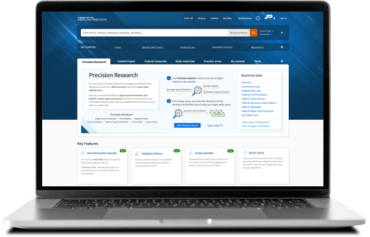Westlaw Precision came to market last year with a promise to help legal researchers find what they need faster and with greater confidence. We talked to Mark Baker, one of the lead product developers at Thomson Reuters to gain insight on how Westlaw Precision helps courts operate more efficiently and deliver on their promise of fairness and access to justice.
What’s at stake for judges and their staff when doing legal research?
Mark Baker: Judges and their staff need to be sure that they have found all relevant precedent and do so as efficiently as possible. They also must know whether each authority that they find is still good law.
How does Westlaw Precision help researchers be certain that a case is still good law?
Mark Baker: Until now, citators have only been able to indicate that there are issues with a case without identifying what in a case was overruled. Westlaw Precision includes several new KeyCite enhancements, including KeyCite Overruled in Part. This tool shows you the specific point of law in a case that has been invalidated and quickly surfaces the relevant language from the overruling decision. This allows courts and their staff to quickly identify whether a party is relying on a point of law that is still good law.
How does Westlaw Precision save time and improve the quality of legal research?
Mark Baker: Westlaw Precision includes several new features that deliver these benefits, such as Precision Research and KeyCite Cited With.
Precision Research was built by a team of over 250 attorney editors that we added to our editorial team to mark up and classify case law in more useful ways for our customers. Precision Research dramatically improves research speed and quality by enabling lawyers to target precisely what they are looking for: legal issues, issue outcomes, fact patterns, motion types, motion outcomes, causes of action, party types, and more. In testing with more than 100 attorneys, Precision Research users found relevant cases more than twice as fast as those using traditional search methods, and 90% of participants said they found cases using Precision Research that they might not have otherwise found.
KeyCite Cited With identifies cases that are frequently cited with a decision, which allows customers to find similar cases even when the cases do not cite each other.
How does Westlaw Precision help researchers keep track of their research trail?
Mark Baker: Another new feature in Westlaw Precision is Graphical View of History. Using this tool, customers can visualize their research history and identify the documents they spent more time reviewing, which saves time retracing prior research.
What’s the risk of using a less precise legal research tool?
Mark Baker: With a less precise legal research tool, judges and their staff may spend more time on their research and may miss important authorities.
Why is it important for courts to use Westlaw Precision?
Mark Baker: Like many attorneys, judges and their staff must balance identifying relevant precedent with limited resources. Westlaw Precision helps court researchers find applicable law quicker and with greater confidence that important decisions have not been missed. Several court systems are already using Westlaw Precision to improve the quality and efficiency of their legal research, which leads to a better experience for litigants, their attorneys, and the courts and their staff.
To alleviate delays in court and mitigate risk, judges and their staff need the right tools to ensure that a decision is made quickly and with confidence.
With Westlaw Precision’s speed and precision, judges and staff can be more confident in their legal analysis and decision-making process.









